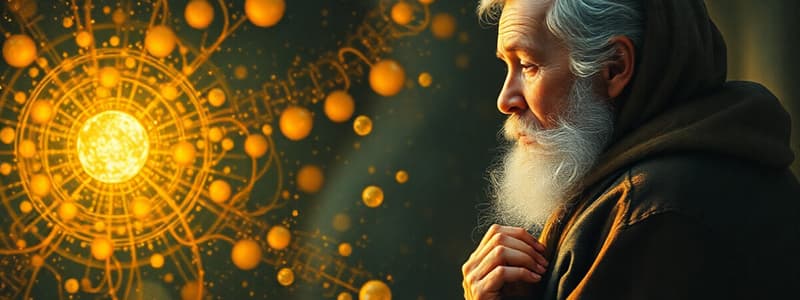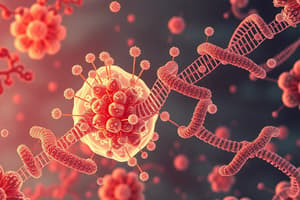Podcast
Questions and Answers
What is the primary biological effect of the aging process on an organism?
What is the primary biological effect of the aging process on an organism?
- Transformation into a less healthy and less fit state. (correct)
- Enhancement of tissue and physiological functions.
- An increase in resistance to environmental stress.
- Conversion to a more efficient and healthier state.
What is a key characteristic of senescent cells?
What is a key characteristic of senescent cells?
- Decreased size of the nucleus and nucleoli
- Decreased number of lysosomes and cytoplasmic microfilaments
- Flattened and enlarged morphology with increased -galactosidase activity (correct)
- Reduced -galactosidase activity
Which of the following is NOT a typical characteristic of cellular aging?
Which of the following is NOT a typical characteristic of cellular aging?
- Decreased resistance to stress.
- Increased susceptibility to disease.
- Reduced tissue and physiological function.
- Increased repair of damaged DNA. (correct)
What change in the plasma membrane is associated with cellular aging?
What change in the plasma membrane is associated with cellular aging?
According to the provided material, what is a significant factor that fuels cancer development?
According to the provided material, what is a significant factor that fuels cancer development?
What is a key alteration observed in the nucleus during cellular aging?
What is a key alteration observed in the nucleus during cellular aging?
What role do tumor suppressor genes play in preventing cancer?
What role do tumor suppressor genes play in preventing cancer?
What mechanisms can induce cellular senescence?
What mechanisms can induce cellular senescence?
What change happens to cellular lysosomes during the aging process?
What change happens to cellular lysosomes during the aging process?
What effect does dietary restriction after adulthood have on lifespan, according to the text?
What effect does dietary restriction after adulthood have on lifespan, according to the text?
Which of the following specifically describes apoptosis?
Which of the following specifically describes apoptosis?
What is the relationship between cancer risk and age?
What is the relationship between cancer risk and age?
What does the term 'cell senescence' refer to in the context of cellular aging?
What does the term 'cell senescence' refer to in the context of cellular aging?
What is the dual role (Yin and Yang) of cellular senescence?
What is the dual role (Yin and Yang) of cellular senescence?
What is the primary function of cellular senescence?
What is the primary function of cellular senescence?
What could be the potential impact of molecules secreted by senescent cells?
What could be the potential impact of molecules secreted by senescent cells?
What is the repetitive DNA sequence found in human telomeres?
What is the repetitive DNA sequence found in human telomeres?
How many telomeres are present in a typical human cell?
How many telomeres are present in a typical human cell?
What is the effect of telomere shortening on normal somatic cells?
What is the effect of telomere shortening on normal somatic cells?
What is the role of telomerase in cancer cells?
What is the role of telomerase in cancer cells?
What is the primary function of telomeres in cellular biology?
What is the primary function of telomeres in cellular biology?
What can happen when a cell loses the function of p53 and continues to divide despite having short telomeres?
What can happen when a cell loses the function of p53 and continues to divide despite having short telomeres?
According to the provided content, what is the 'clock' that limits the number of times a cell can divide?
According to the provided content, what is the 'clock' that limits the number of times a cell can divide?
What is the cellular process that occurs when telomeres shorten to a critical length?
What is the cellular process that occurs when telomeres shorten to a critical length?
What is the primary effect of a poor environment, such as dietary restriction, on the trade-off between growth and maintenance according to life-history theory?
What is the primary effect of a poor environment, such as dietary restriction, on the trade-off between growth and maintenance according to life-history theory?
In lab animal studies, what is typically observed in insulin/IGF mutant organisms with life-span extending mutations?
In lab animal studies, what is typically observed in insulin/IGF mutant organisms with life-span extending mutations?
What is the effect of a mild reduction of function of the IR (insulin receptor) gene on health?
What is the effect of a mild reduction of function of the IR (insulin receptor) gene on health?
What is the primary function of the somatotropic axis?
What is the primary function of the somatotropic axis?
What was observed in mice heterozygous for a deletion of the IGF-1 receptor gene in the study by Holzenberger (2002)?
What was observed in mice heterozygous for a deletion of the IGF-1 receptor gene in the study by Holzenberger (2002)?
What is the relationship between the p53 gene and aging in the discussed mouse model?
What is the relationship between the p53 gene and aging in the discussed mouse model?
In the context of aging, the content suggests that insulin/IGF-1 signalling pathway genes are associated with:
In the context of aging, the content suggests that insulin/IGF-1 signalling pathway genes are associated with:
What was the conclusion regarding the relationship between insulin signalling and aging?
What was the conclusion regarding the relationship between insulin signalling and aging?
Flashcards
Aging
Aging
The process that transforms a healthy organism into one that is less healthy and fit for its environment.
Apoptosis
Apoptosis
A type of cell death where cellular machinery is activated to break down the cell in a controlled manner.
Cellular Senescence
Cellular Senescence
A state where a cell stops dividing and enters a state of permanent growth arrest. This is often triggered by stress or damage.
Senescence Morphology
Senescence Morphology
Signup and view all the flashcards
Senescence
Senescence
Signup and view all the flashcards
Tumor Suppressor Genes
Tumor Suppressor Genes
Signup and view all the flashcards
Cancer Risk and Age
Cancer Risk and Age
Signup and view all the flashcards
Tumor Suppression
Tumor Suppression
Signup and view all the flashcards
Evolutionary Balancing Act: Aging and Tumor Suppression
Evolutionary Balancing Act: Aging and Tumor Suppression
Signup and view all the flashcards
Insulin/IGF-1 Signaling and Aging
Insulin/IGF-1 Signaling and Aging
Signup and view all the flashcards
Trade-offs in Insulin/IGF-1 Signaling
Trade-offs in Insulin/IGF-1 Signaling
Signup and view all the flashcards
Lifespan Extension in Insulin/IGF-1 Mutants
Lifespan Extension in Insulin/IGF-1 Mutants
Signup and view all the flashcards
Insulin-like Pathway in Drosophila
Insulin-like Pathway in Drosophila
Signup and view all the flashcards
Insulin Receptors in Mammals
Insulin Receptors in Mammals
Signup and view all the flashcards
Insulin Signaling and Type 2 Diabetes
Insulin Signaling and Type 2 Diabetes
Signup and view all the flashcards
IGF-1 and the Somatotropic Axis
IGF-1 and the Somatotropic Axis
Signup and view all the flashcards
IGF-1 Receptor and Lifespan in Mice
IGF-1 Receptor and Lifespan in Mice
Signup and view all the flashcards
What are telomeres?
What are telomeres?
Signup and view all the flashcards
What is telomerase?
What is telomerase?
Signup and view all the flashcards
What is cellular senescence?
What is cellular senescence?
Signup and view all the flashcards
How do short telomeres affect cell division?
How do short telomeres affect cell division?
Signup and view all the flashcards
How does telomerase relate to cancer?
How does telomerase relate to cancer?
Signup and view all the flashcards
What happens when tumor cells lose p53?
What happens when tumor cells lose p53?
Signup and view all the flashcards
How are telomeres linked to aging?
How are telomeres linked to aging?
Signup and view all the flashcards
What is the main function of telomeres?
What is the main function of telomeres?
Signup and view all the flashcards
Study Notes
Cell Ageing Process
- Cellular aging is a response to damage or stress.
- This response can manifest as cell death (apoptosis) or arrested cell growth (cell senescence).
- Aging is a biological process that transforms a healthy organism into one that is less healthy.
- Cellular aging is important in regulating the cell cycle, including the prevention of cancer.
Objectives
- Understanding the aging process at the molecular and cellular levels, including characteristics.
- Understanding the molecular and physiological aging process, such as IGF and p53 signaling pathways.
- Establishing the association between telomeres and cellular aging.
What Is Aging?
- Aging is a biological process.
- It converts a healthy organism into a less healthy one.
Aging
- Reduced tissue/physiological function.
- Increased susceptibility to disease (age-related diseases).
- Reduced resistance to stress (both physical and psychological).
Changes in the Plasma Membrane
- Structural changes lead to changes in permeability.
- Less fluid due to an increase in saturated fatty acids.
Nuclear Changes
- Chromatin becomes more condensed (increase cross-links, disulfide bonds between histones).
- Implication: DNA damage less likely repaired.
- Cells in culture eventually stop growing (senescence) due to changes in factors regulating the cell cycle.
Cytoplasmic Changes
- Increased volume with age.
- Lipofuscin (age pigment) found in non-dividing cells (e.g., nerve and muscle cells).
- Lipofuscin appears as yellow-brown granules.
Mitochondrial Changes
- Decrease in the number of folds (cristae).
- Decrease in the number of mitochondria.
Lysosomal Changes
- Reduced activity leads to the accumulation of cellular garbage (e.g., lipofuscins).
- Release of enzymes leads to cell death.
Pre-programmed Cell Death (Apoptosis)
-
Apoptosis vs. Necrosis
- Necrosis: external cause (trauma), random DNA breaks
- Apoptosis: internal cause (cellular suicide), non-random 180 base fragments
-
Apoptosis as a natural developmental process (e.g., interdigital tissue, neurons).
Cellular "Aging" Responses: Yin and Yang
- Good news (prevents cancer).
- Bad news (promotes aging).
Evolution of Long-Lived Organisms
- Life span varies between single-celled organisms, multi-cellular organisms with post-mitotic cells, and organisms with renewable tissues.
- Cell division is risky.
- The risk of cancer increases with age.
Cancer
- Cancer risk rises exponentially with age
- Driven by somatic mutations.
- Mutations from endogenous & exogenous DNA damage.
Tumor Suppression & Aging
- Genes protecting from cancer (tumor suppressor genes)
- Damaged cells die or arrest growth (apoptosis or senescence).
- An evolutionary balancing act between cancer protection and cellular aging.
Senescence Morphology
- Senescent cells become flattened, enlarged, and exhibit increased β-galactosidase activity.
- Larger nucleus and nucleoli.
- More multinucleated cells.
- Increased lysosomes, Golgi, and cytoplasmic microfilaments.
Cellular Senescence
- Cellular senescence arrests growth in response to potential cancer-causing events.
- Chromatin instability
- DNA damage
- Short/dysfunctional telomeres
- Oncogenes
- Stress/damage signals
Molecules Secreted by Senescent/Aged Cells
- Disrupt normal tissue differentiation; example: milk production by mammary cells.
Molecular and Physiological Mechanisms of Aging
- Dietary restriction after adulthood reduces aging effects and increases lifespan in lab animals.
- Insulin/IGF-1 signaling pathway genes are strongly implicated in aging effects (regulate metabolism & stress responses, influence maintenance functions).
Integrating Molecular Mechanisms with Life History Theory
- Insulin/IGF-1 ('growth' hormones) pathway strongly regulates growth and maintenance trade-offs.
- Poor environment (e.g., dietary restriction) favors maintaining survival and reduces growth and reproduction.
- Conversely, good environment favors growth and reproduction but reduces maintenance.
- Lab animal studies show that lifespan-extending mutations of insulin/IGF-1 pathway mutants perform poorly and do not show evidence of longer lives.
Telomeres and Aging
- Humans have 46 chromosomes and 92 telomeres (one at each end of the chromosome).
- Telomeres are repetitive DNA sequences at the ends of chromosomes.
- Telomeres function in protecting chromosomes
- Separating chromosomes.
- Preventing their fusion, in turn, leading to genomic instability.
- Telomeres act as a "clock".
- The shortening of telomeric sequences is a regulator of a cell's division capacity.
- Healthy human cells are mortal because they can divide a limited number of times; aging occurs from each division.
- Telomere shortening may function as a molecular clock.
Telomerase and Senescence
- In most somatic cells, telomerase expression is low or absent.
- As cells divide, telomeres shorten, which gives signaling to cells to enter senescence.
- Short telomeres signal cells to senesce (stop dividing).
Telomerase and Cancer
- Telomerase is active in cancer cells allowing proliferation, and protecting telomere length.
- Cancer cells often do not age.
Short Telomeres, p53 and Growth Arrest
- Short telomeres trigger growth arrest via a checkpoint signaled by the p53 checkpoint mechanism.
- If cells of a tumor still have p53, this works.
- If tumor cells lose p53, then cell division continues, leading to chromosomal rearrangements.
- Genomic instability can promote tumorigenesis
What do Telomeres do?
- Protecting chromosomes.
- Separating one chromosome from another in DNA sequence
- Without telomeres, chromosome ends would be "repaired," leading to fusion and massive genomic instability.
Telomere Function (cont.)
- Telomeres are a clock that regulates how many times an individual cell can divide.
- Telomeric sequences shorten each time DNA replicates.
- Once telomere shrinks to a certain level, cells stop dividing, slow down metabolism, age and die.
Telomeres & Aging
- Healthy human cells are mortal because of a finite number of cell divisions. Dividing older each time they divide, until they age and die.
- Telomere shortening may be a molecular clock, which counts the number of times a cell has divided and when telomeres are short, cellular senescence occurs.
How Does Telomerase Work?
- Telomerase is active in germ cells, in vitro immortalized cells, a vast majority of cancer cells, and possibly some stem cells.
- High telomerase activity exists in germ cells, stem cells, epidermal skin cells, follicular hair cells, and cancer cells.
- Some cells are immortal due to switched-on telomerase.
- Examples include blood cells and cancer cells.
Human Aging
- The Greek god Zeus granted Tithonus the gift of immortality but not of perpetual youth.
- Tithonus aged but could not die.
- Tennyson's poem "Tithonus" reflects the desire for longer lives, even though it may be without youthful vitality.
Studying That Suits You
Use AI to generate personalized quizzes and flashcards to suit your learning preferences.



